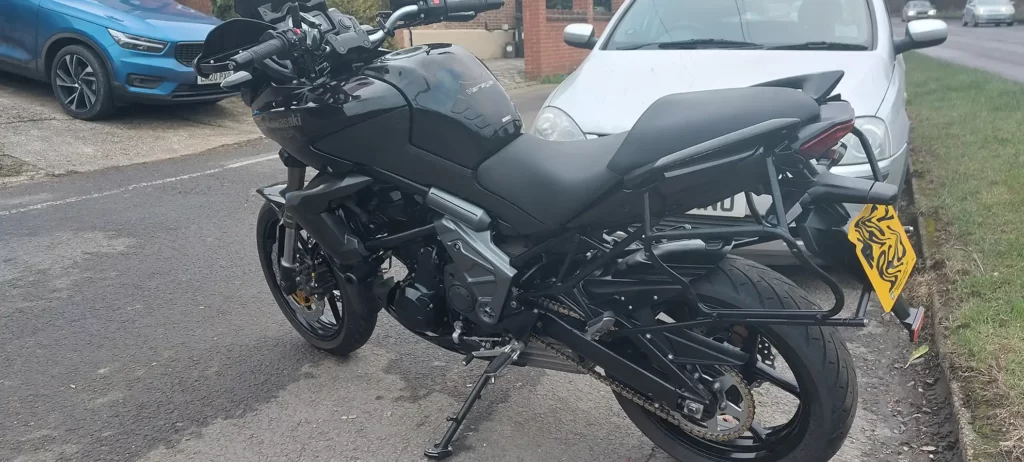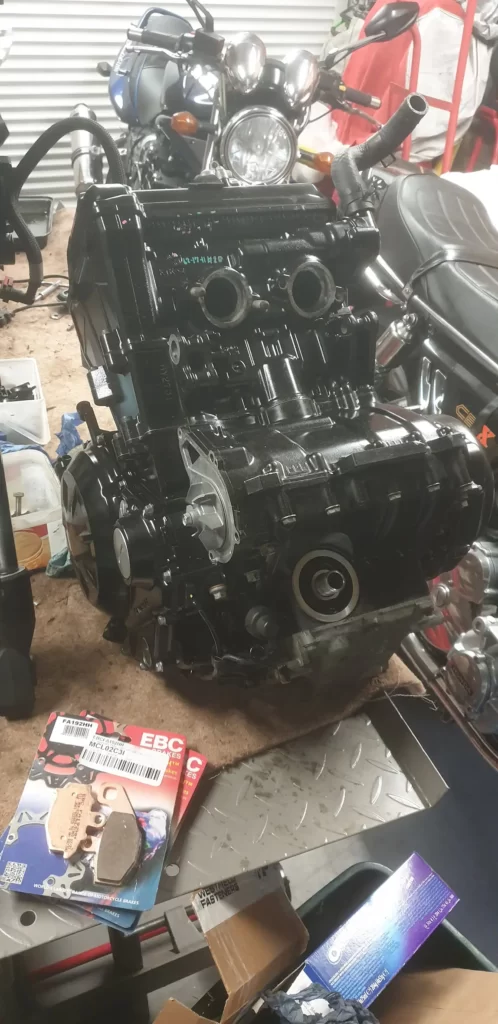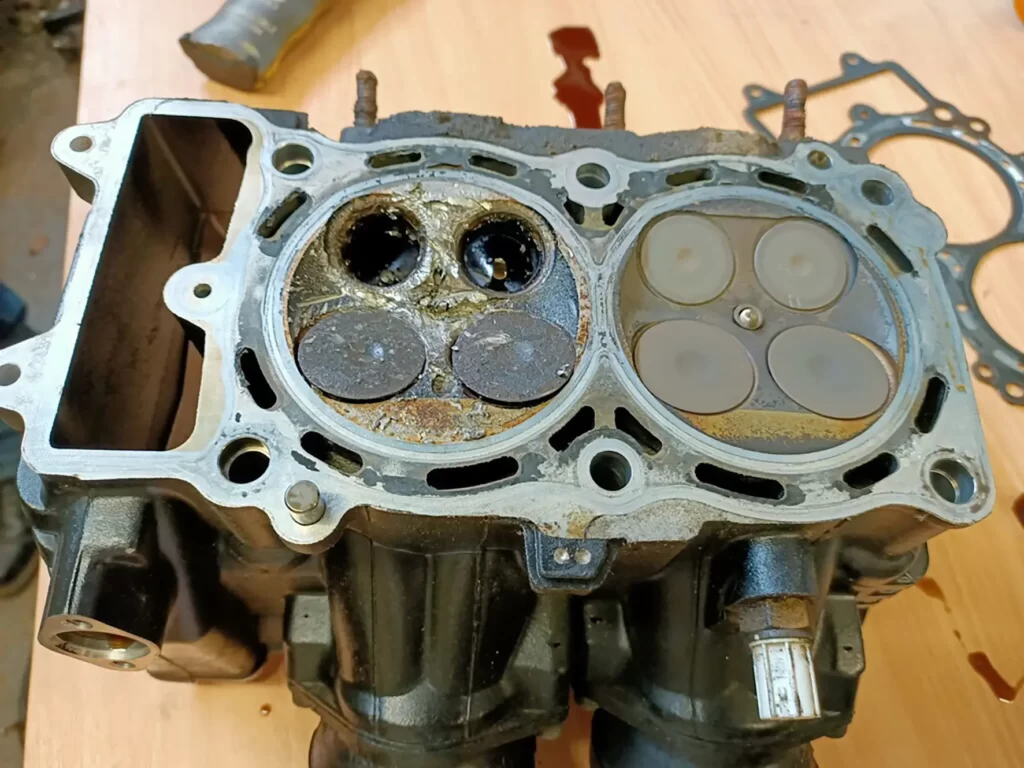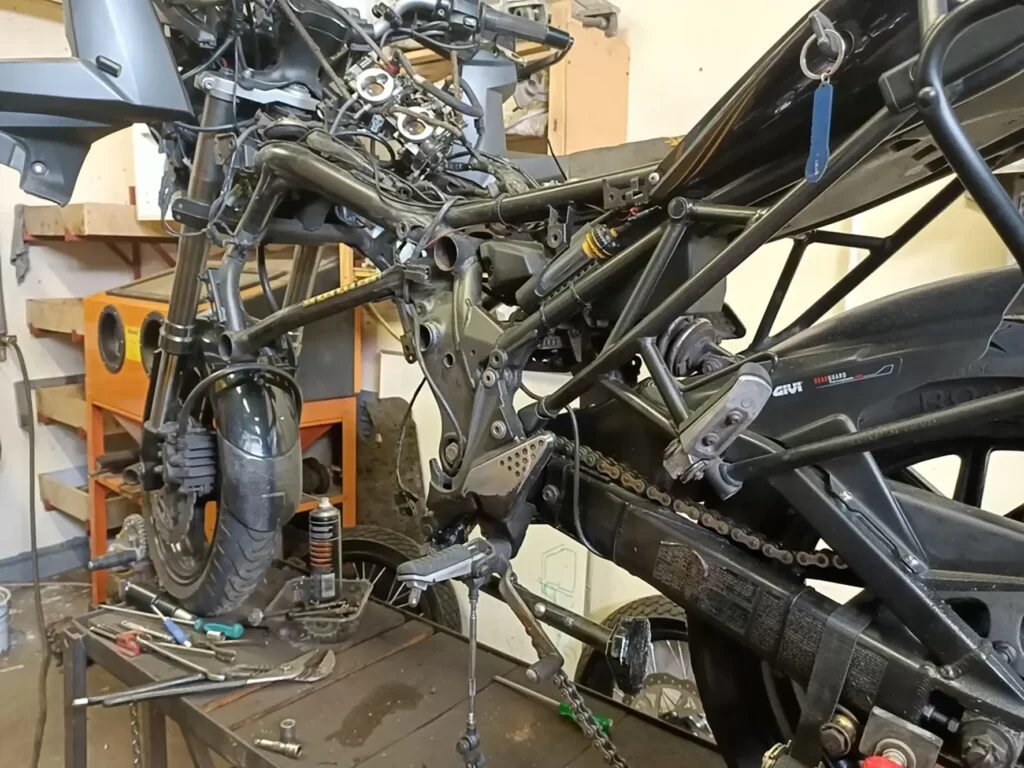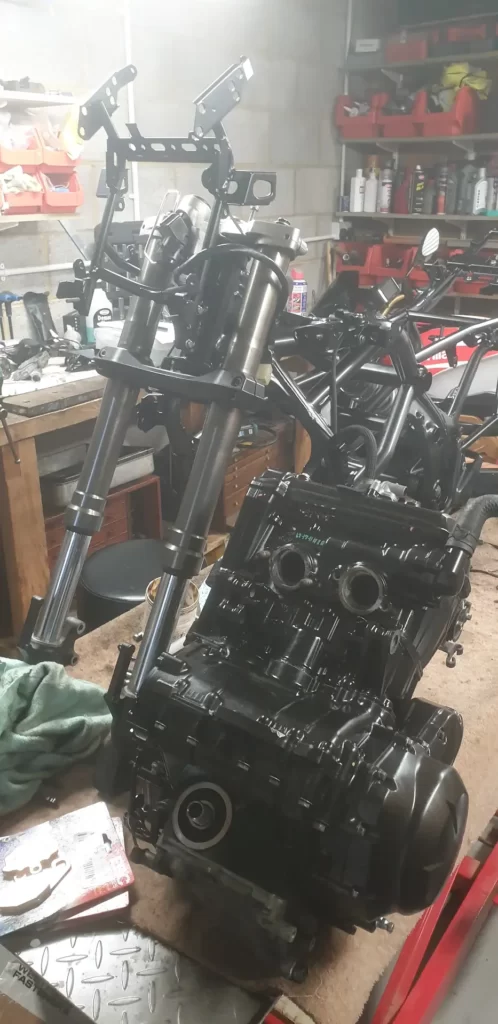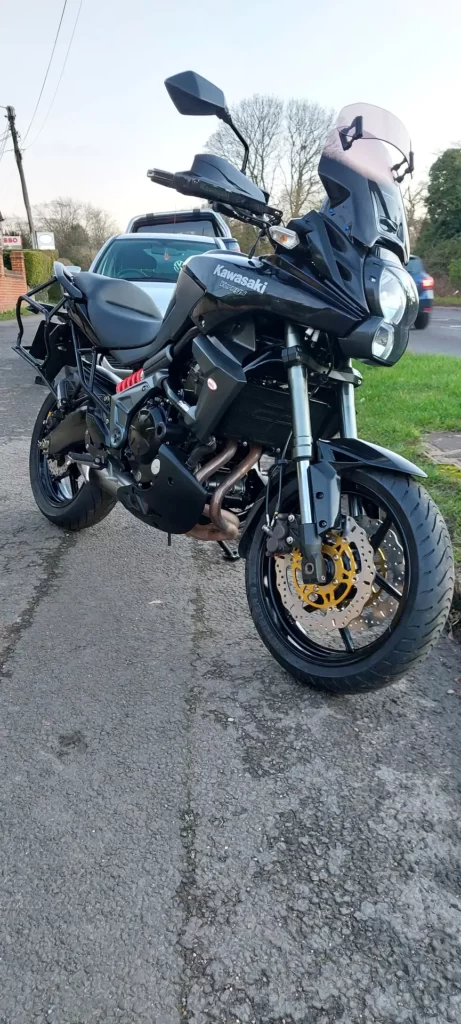You might have seen the post in groups.io back in late August “For sale Kawasaki 650 Versys one careful owner.” I needed to put my glasses on to read the bit about breaking for spares or winter project. As they say every picture tells a story and this was one of the immovable force meeting the immovable object. Winter project was the bit that caught my eye. I had been looking for something old like a 1980s Yamaha two-stroke 250-350 but prices are a bit silly at the moment – unless anyone knows of one going cheap?
I am not mad keen on Adventure bikes, they are very big and very heavy and covered head to foot in plastic, I just don’t trust a bike whose handlebars are the same height as my nipples and I am not vertically challenged. This market seems to be taken over by BMW who have built a tank and then added a super tanker, they are as high as a 3-storey house and weigh as much as a cubic metre of bricks, and that is before you add the optional extras catalogue and fitted 3 kitchen sinks on the back. I take my hat off to Ewan and Charlie who must have wrestled these bikes across tough terrain in the “Long Way Round”. They are so popular that a TVAM run could be re-classified as a GS run, there is even a technique for climbing aboard these large creatures, just like a horse, one foot in the stirrup, swing the leg over, sit in the saddle, grab the reigns and ride off into the sunset. I have many a time stopped behind one at a junction while riders who are vertically challenged rock from side to side on tip toe trying to control their beast. By comparison, the Versys is about 60-80kg lighter, even though the handlebars are still at nipple height, but power to weight ratio is still king in the horse power world and 69bhp will still march you down the road at a fair rate.
Back to the bike in question, I almost bit off Simon’s hand to purchase this project (sorry Simon) and once agreed on a price, we met his mechanic to collect the pieces. On arrival, we were confronted by half a basket case, not my ideal project as I like to see what it looks like before it‘s in pieces. The mechanic had decided to do an engine removal to find the problem. It would have been easier to put a small endoscope connected to a smart phone down the plug hole to tell that this was terminal. Simon trailed the bike back to my workshop with all the bits in my car. With the bike on the work bench and the parts in boxes it stayed there for a few weeks while a plan was hatched.
The engine in question had a few problems….one such issue being the top end was past repair. It looked like one of the exhaust valves had a hairline crack, which over time cracked and punched a hole in the piston and disappeared into the depths of the engine. The other valve became bent in sympathy, broke off and buried itself into the top of the piston. With all this going up and down at 10,000rpm destroyed the valve guild and seats, end of story!
First thought was to fit another engine and get rid of it. I started to read some test reports on the bike to find that this was a good mid-range bike with many plus points, but on closer inspection things were not well with this particular bike, so the best course of action was a complete nut and bolt restoration. Let’s face it, it was halfway there already. An afternoon was spent disassembling the bike down to the last washer and putting it into piles, along with some pictures along the way to give me half a chance of putting it back correctly.
Painted parts to powder coating, special expensive looking bolts etc. to platers and small screws, bolts, washers etc. replaced with stainless steel items. Modern machinery design is full of small metal and plastic fittings held together with small substandard fasteners that rust very easily and plastic clips that are not very robust and end up being destroyed on removal. They also cover the frame in holes to hold these fittings, which can produce a stress point or the opportunity to let in water – not good. Needless to say, some of these fittings didn’t come quietly.
Engine next – even though this bike has been around since the early 2000s, there were not many Versys parts and, if available, they were very expensive. Any chance of finding a new top end was little to none, so next choice was a complete lump. The bike industry is very clever in their model line-up, the Versys and Ninja are almost the same bike with a change in riding position, different plastic, a change in suspension and of course the name on the side. The new Kawasaki Z650 which is meant to be a new retro model of the 1980s Z650 is also a Ninja with a different tank and plastic, but nothing like the old Z650 which we all know was a baby Z900. Based on this, I found a 2019 Ninja engine with 3000 miles that had bitten the dust early in its life, going very cheap. On checking the spec between the 2 bikes, it was on its way.
Like all good projects, work got in the way for a month, which gave time for the parts to arrive – postman not too happy with the heavy boxes. First job was to make sure the same parts had been returned (always take plenty of pictures first), clean and grease all threads, then bring out the pictures and manuals. Simon had put me on to a free online manual and along with the online parts catalogue from Cradley Heath Kawasaki, this was my reference library. First on was the wiring harness which had been the last off. This bike had 5 previous owners who had all added their personal touch to the harness. I wanted this bike to be standard and some of the connections were, should we say, ‘not good’. The parts I removed filled a carrier bag. All connections checked. Next on were the back and front suspension. Rear swinging arm was cleaned and checked ok, front was a different story, head bearings replaced, forks taken apart and filled with new oil. I had taken apart many right way up forks in the past, but never upside down forks. Afraid that the spring might pop out and go through the garage roof, I enlisted a mechanic friend to do the job while I watched. Point to note, it is easier to crack the top nut while clamped in the bike, if not use a rattle gun very carefully. Fork oil I think should be changed about every 4 years along with the brake fluid, but listening to members who are paying well over £1,000 for service with valve clearance check, I can see why it is not usually done. I can check my 6-cylinder 24 valve CBX in a morning, but there again I don’t have a lot of plastic to remove first.
I wanted to replace the after-market exhaust for a standard unit. I found one online close to me, but it was expensive, also it was not for the year of this bike, so I was unsure if it would fit. The bike at this stage was still sitting on the frame which would not allow me to check if it would fit correctly. As the item had been advertised a while there was no rush, but just at the point I was ready, it had gone. Never mind, 2 weeks later a new silencer came up for sale, cheaper than the other unit and the correct year. The owner had taken it off his own bike when new, fitted another unit and parked this in the corner of the garage – result!
Next in was the engine. This was easy as it was only a twin cylinder and light (compared to a Honda CBX), and having been used as a stress member, had no bottom tubes. Once in, bolts tightened, the bike was then strapped to the roof beams and the work bench lowered, this allowed me to fit the wheels and brakes. Wheel bearings and seals needed replacing. I had the wheel spacers machined out of stainless steel as the factory ones are of poor quality and become corroded very easily.
The brakes were another story, all discs worn below service limit, this was due to seized calliper pistons. A lot of money later, new discs, stainless pistons and seals and, whilst I was at it, new brake liners. Never mind, I did say things were not well with this bike. This all might sound very easy, but much midnight oil was burnt dry fitting parts many times until I was happy that was the best possible fit or correct to pictures manual etc. I am also a bit OCD about standardisations of parts and of the belief that if it looks right then it is right. This is left over from both my engineering days and career as a sparky. I could never understand electricians that would fix a socket with one screw 70mm long and the other 25mm, that is just sheer laziness.
The tank needed painting and removal of dents, the plastic also required repairing and polishing to look like new. Whilst this was happening, I started to fit the auxiliary parts to the engine. This is where we discover the 2 engines are not the same. The neutral switch was not the same – this was an easy swap of the cover and connection on the end of the selector drum. Next was the alternator which had a different plug on the end, this was also a swap of the internal components with same outside cover. The clutch was another story, the Versys and Ninja engines both have 2 different cable mounts, but the clutch operation mechanism was different. I could have once again switched them over but chose to take the best parts from a Versys and Ninja clutch cable and have a new one made. Yes, I have a non-standard clutch cable, but “Vinhill” cables are very good and last forever.
With the bike almost together and before fitting all the plastic, I needed to test the electrical system. I was still unable to start the bike as once more, some parts I had forgotten, needed powder coating and it was Xmas. On the bar humbug front, this is always a difficult time for my bike builds as everything closes down for 3 weeks and I am useless at planning ahead. No real issues with the electrics, apart from a few lamps (bulbs are what you put in the garden) a fuse and a bit of head scratching for an hour as the headlight did not work, until I discovered the engine needed to run. Xmas over and all parts back and fitted, fluids topped up remembering to fit the coolant drain plug, too late, button pressed, and it all works, or did it? The fault light (FL) came on and not sure why. Google is a wonderful tool for information. If I grounded out a certain wire in morse code, the FL would tell me what was wrong. It appeared that the air pressure switch was faulty and, on inspection, I had forgotten to fit the pipe to the inlet manifold. Don’t forget, this is part of the bike that I did not dismantle. Once gone through a few heat cycles, on with the plastic. At this point I found out the garage was only just high enough to fit the screen in between the rafters with the work bench extended.
Maybe it is me just getting old, but bikes designed and built in the late 20th century looked sexier with flowing lines from head to toe, this was maybe because everything was conceived on a drawing board with paper and pencil, designers were not allowed to use rulers but just their imagination and a sweeping pencil. Nowadays everything is Cad Cam and the computer just joins the dots and kicks it down the to the factory floor without seeing a human. This is probably why the more the build continued, the more I started to remember why I am not over the moon about adventure bikes (just my opinion!).
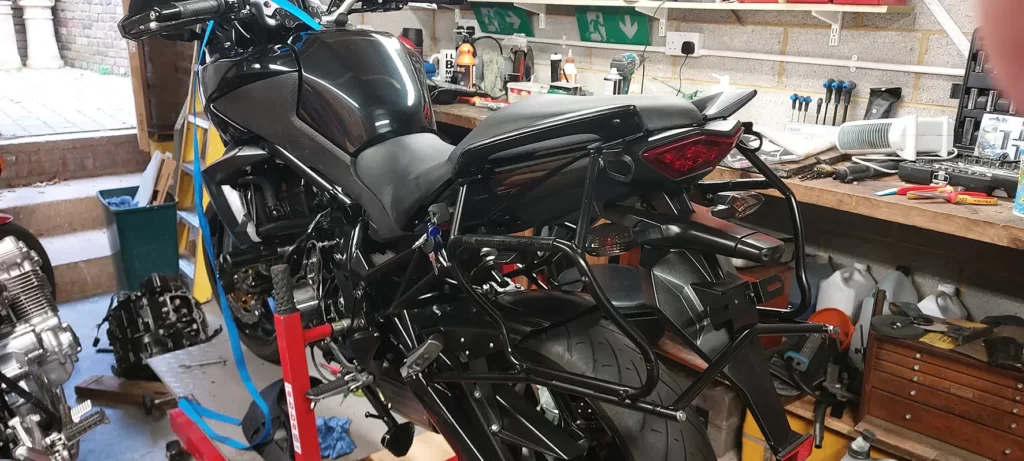
Was it worth it? Financially not. This will never be a collector’s item thank goodness and adventure bikes will go as quickly as they came. It was never my intention to do a nut and bolt restoration on a bike like this, but it kept me out of trouble for a few months. What am I going to do with it? Not sure, if a TVAM member offers me a very good price, I might just sell it. If not, I will use it during the summer to see what all the hype is about and then sell it as it doesn’t fit into my collection, or it might change my mind on adventure bikes altogether. It would have been nice if Kawasaki fitted it with a few luxuries, cruise control, quick shift or ABS, the sort of electronics you find on today’s machinery.
One more thing that was letting the side down was the standard rear shock, which was old and rusty and could be seen from every angle. So once more hand in pocket and, £330 later I fitted a YSS shock, very pretty. JOB DONE!
Jon Slattery
First published in Slipstream April 2022

